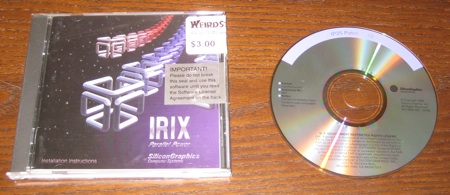A little while ago, an article made the rounds which detailed a visit to The Weird Stuff Warehouse in Silicon Valley. Since I have a thing for weird, obscure stuff, I knew I had to pay a visit.
I didn’t find much interesting material there, though that’s probably more an indication of my own changing interests (there was a time when I would have enjoyed buying up vintage hardware for cheap). They did have an old MPEG-1 ISA bus video decoder board. There wasn’t much in the way of old entertainment software, which is my current interest. However, I did find an old SGI IRIX OS CD-ROM. Since SGI was more or less synonymous with multimedia back in the 1990s, I thought this disc might have some classic multimedia examples.

The manual that comes in the jewel case seems to focus exclusively on using FlexLM.
When ripped, ‘file’ identifies the disc image as “SGI disk label (volume header)”. Is that the same as SGI’s XFS? I installed Linux’s XFS module but was unable to mount the filesystem. Scanning through the image, I didn’t fnd any strings that would indicate more common multimedia types from the era.
Weird Stuff Warehouse also had an SGI Octane machine for running the OS. You have no idea how hard it was to resist the urge to buy it and run the FATE client on it.
Maybe ‘file’ picked up on a partitioning system? Check through the kernel configuration options for supported disk layouts; I think you might find it near BSD disk slices and other ones I never got around to playing with.
Googling a bit, I found this: http://www.unixwerk.eu/bsd/ufsmount.html
I think I’d look under “advanced partition selection”. The files on the disc might have been thrown in compressed tarballs, regardless of format.
Further googling picks up SGI’s implementation for XFS on Linux: http://oss.sgi.com/projects/xfs/
I installed Ubuntu’s XFS-related stuff and tried to mount the ripped image using ‘mount -t xfs …’. Mount didn’t complain about an unknown file type so I assume the XFS stuff got installed just fine.
You should probably test using EFS, iirc that’s what most IRIX CD’s use.
If you want to have another weird cd, try to find originall OpenSTEP installer discs. They’re in byteswapped UFS and you also need some magic mount parameters to read them :)
Why didn’t you buy the Octane? How much was it? Running FATE on Irix sounds funny.
IRIX used a filesystem called EFS before XFS, you may be seeing that.
I have an Octane. I’ve been meaning to get FFmpeg running on it, just because. Still haven’t got round to doing it.
Why didn’t I spring for the Octane? A) Because I didn’t want to toy with such a machine (got enough to worry about right now); and B) because I had a weird feeling that Mans would reveal he already owned one. :-)
About price, I didn’t check the price on the Octane (don’t think it had one yet). When I saw the stack of IRIX CDs, I asked if they had any hardware to run it on. They took me to a curtained-off, employees-only section and showed me the Octane, but it was still being assessed for sale.
Wow… a blast from the past (I worked for SGI when those covers were current).
The filesystem will indeed be EFS (Extent File System, if you’re curious). There is Linux support available:
http://aeschi.ch.eu.org/efs/
You’ll find the DMedia system under Irix fascinating. SGI realized early on that they needed a good multimedia story, and built a pretty impressive framework for supporting it into Irix (starting with 4.0, if memory serves). It was extremely capable by 5.0. I’ve heard it claimed that DirectMedia was basically a rip-off of SGI DMedia, but have no hard evidence either way.
SGI licensed Indeo from Intel, Quicktime from Apple, and quite a few other codecs of the era. I remember seeing all the source code in the DMedia tree. The problem was that the vendors absolutely gouged SGI over licensing, so including (then) more modern codecs became prohibitive. This was also before the MPEG-LA, and even licensing the MPEG-1 patents cost so much money that they had to individually license MPEG-1 software encoding.
At the time doing real-time compression on a 50MHz or 100MHz MIPS CPU wasn’t doable, so SGI had a couple of extremely overpriced compression cards. With the Indy they shipped the world’s first (AFAIK) webcam, but it’s bandwidth requirements were so high that it was nearly useless unless you were on a LAN. And if you were on a LAN, you didn’t need to video conference. :)
If you’re looking for games, I strongly suggest getting the Indizone CD’s. These were the results of game competitions which SGI ran back in the glory days, when working there was kinda like working for a Hollywood version of a computer company. The other thing would be if you come across some of their developer program disks, you’ll also find some pretty interesting source on these.
As for an Octane, it’s a very nice system, but it will burn a lot of power (it’s a cut-down Origin system, basically). I’d suggest grabbing an O2 if you see one.
As always, thanks for the tips, Ian.
AFAIK SGI cdroms used rockridge FS. That’s why u can’t read it. Even if you could i believe u also need a jumpable cdrom drive capable of readign 512K blocks.
I own an Octane with a SGI Toshiba cdrom =)
Buy one, it’s one of those nice 40 kilos thing u won’t regret turning on… noisy, in every way haha. =)
good luck